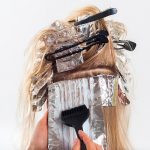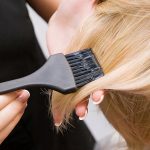
How Much Does It Cost To Dye Your Hair? Explore Average Costs
Hair specialists with extensive training and passion work as hair stylists today. Many of them consider themselves hair artists, and they are professionals in hair color. They are true masters of their trade, and nothing makes them happier than a satisfied customer. Any change in hair color will be guided by a hairstylist in a mid- to high-end salon. You’ll walk out of the salon feeling energized, assured, and well-equipped to take care of your color between salon sessions. So, how much does it cost to dye your hair?
Table of Contents
Hair Dye Types
When you get your hair dyed (or do it yourself), you will need to choose from a few different types of dye. Your primary deciding factor should be how long you want to have the new color.
The integrity and general health of your hair should also be taken into account. Ask your stylist for advice if you’re unsure of the type of hair dye to use.
Temporary Hair Dye
Lasts: 1-5 shampoos
When it comes to coloring your hair, temporary hair dye isn’t typically what comes to mind. These transient dyes will disappear after a few shampoos.
If your hair is very porous or damaged, avoid using temporary hair color. It can stain your hair an unflattering, faded shade of the original temporary dye.
Semi-Permanent Hair Dye
Lasts: 8-10 shampoos
Temporary hair dye is followed by semi-permanent hair dye. Because they don’t contain ammonia, these dyes are kinder than their permanent and demi-permanent, longer-lasting cousins.
Most people cover their gray hair with semi-permanent hair dye, touch up their roots, grow out permanent hair color, or maintain shine and glossiness.
Demi-Permanent Hair Dye
Lasts: 20-24 shampoos
You might choose a demi-permanent dye if you’re a little more dedicated to the color you want. These dyes don’t contain ammonia, but they do contain a small amount of developer (peroxide), which enables the color to penetrate the hair cuticle and last longer.
Temporary and semi-permanent dyes coat the hair instead of actually penetrating it. If you use a gentle shampoo for color-treated hair, this type of dye will last up to 10 weeks because it penetrates the hair.
This is perfect for covering grays, touching up roots, blending colors, toning highlights, and reviving permanent colors.
Permanent Hair Dye
Lasts: 6-8 weeks+
The real deal is permanent hair dye. After about 6 to 8 weeks, the color will start to fade as your roots start to spread out, necessitating touch-ups.
Until the hair is cut off, permanent dye will technically remain on your hair. But it will require frequent touch-ups if you want it to look good.
In order to penetrate the hair cuticle and produce color that will last for a long time, permanent dye does contain ammonia and is combined with a developer.
If you want to stay with a color for a long time, use permanent dye. It provides the highest degree of gray coverage.
Hair Bleach
Lasts: Permanent
In most cases, bleach is combined with a toner or hair color that is applied on top of the bleached hair to permanently lift the color of your hair to a lighter shade.
Bleach will be needed to lift hair beyond 2-3 shades, whether you’re going blond or simply choosing a lighter shade than your current hair color.
To create highlights, bleach can be applied all over, to the ends, or in small sections. To lighten hair to the appropriate level, stylists use bleach powder and a developer.
In order to gradually lighten your hair if you want a significant change, your stylist might arrange multiple visits. In doing so, damage is prevented.
Henna Hair Dye
Lasts: 4-6 weeks
Though less frequently used, henna dye is becoming more and more popular. It’s a natural dye with a reddish hue that is derived from the henna plant.
Henna hair dye doesn’t come in a wide variety of colors, but it won’t give you an allergic reaction and lasts for 4-6 weeks before fading.
Techniques Of Hair Dye
These are some of the popular techniques used in salons to apply different types of hair dye. Which method do you want to have completed?
Ombre
Starting price: $150+
If your natural hair color is dark enough, you can use the ombre technique to begin with a dark base that gradually becomes lighter toward the ends of the hair.
Ombre hair color penetrates deeper into the hair than balayage highlights, which are painted in a similar manner on the middle to ends of the hair. All of your hair’s layers will be completely saturated with the lighter hair color at the ends.
As a result, the hair’s tips are much lighter in color than the hair’s root area. A double process is typically needed to create an ombre effect.
Reverse Ombre
Starting price: $150
You might prefer the reverse ombre if you enjoy the gradient color of balayage and ombre dyeing techniques but dislike lighter ends. At the roots, halfway down, the hair is lightened.
From the hair’s ends upward, a darker color is then blended. The outcome is an ombre effect that is inverted or reversed, with dark ends and light roots.
Single Process Color
Starting price: $35+
Want to have a uniform hair color? That is a single process color that offers uniform coverage. Single process color doesn’t have to be monotonous or flat.
To add more dimension and depth to the color, your stylist can combine a few shades.
A single process color is quicker to apply than other types, works well to cover gray, go 2-3 shades darker, and add shine and gloss, and is less time-consuming overall.
Double Process Color
Starting price: $100+
You will require a double process color if you want a hair color that is significantly lighter or more vivid than your current shade. The hair is first lightened (either completely or in sections) in a double process before being colored.
Whether the new hair color is a blonde, brunette, or more vibrant shade, stylists use a double process to create a lighter canvas. Color that uses two processes takes longer to develop and is always more expensive.
Sombre
Starting price: $100+

Consider the sombre technique if the full ombre color is a little too much for you. Sombre is an acronym for “subtle ombre.”” It’s a more gradual change in color, usually from a light shade of brunette to blonde.
To get the gradient appearance of the ombre technique without as much color saturation at the ends, ask for caramel sombre, mocha sombre, or bronde sombre. Consider using two processes to achieve a somber effect.
When You Dye Your Hair, What Exactly Are You Paying For?
Over-the-counter boxed hair color is inexpensive, but the results frequently appear tacky. Cost-effective OTC dyes start at around $10, but more sophisticated OTC color kits can cost up to $30. If your hair is long, thick, or you’re going from dark to light, the cost of the product will be between $40 and $60. Bombshell offers gorgeous, wholesome color processing starting at about $100 for an all-over head color. Let’s face it, all that’s needed is a nice dinner and a couple of hours at the club.
Your hair is among the first physical features that people notice about you. You should refrain from using over-the-counter hair color in order to make the best possible first impression. Using over-the-counter hair dyes has a lot of drawbacks! Not to be forgotten is the time commitment you have on your own. This “do it yourself” and “over the counter” nonsense is dangerous to your hair, and it’s not as cheap as you might think.
You get what you pay for when it comes to hair dye prices, according to the proverb. The most important thing you are paying for is expertise, by far. If you cut corners on coloring supplies and search for the cheapest prices, you won’t get the outcomes you want.
It takes a lot of practice to become an expert at this art form. Successful hair coloring and dying calls for both specialized training and years of experience. A skilled colorist is a creative genius. You can count on them to deliver the best results that complement your entire appearance.
Numerous Factors Affect The Price Of Hair Dyeing Salons.
Hair Kind
The dying process will vary depending on the length and color of your hair. You’ll need to use more dye if your hair is naturally dark if you want the desired effects. In comparison to heads with darker hair, lighter heads require less dye.
It also makes a big difference how long one’s hair is. Short hair requires less dye than longer hair, so the price is lower. You will require products in order to maintain the health of your hair.
Using additional treatments to tame frizzy or wavy hair will be necessary before coloring it. With dry, broken hair, it’s the same. Since they’ll be using nourishing oils to revive the hair, the price of the service will increase.
Location Of The Salon
your salon’s environment. If you go to a high-end salon rather than a regular salon in your neighborhood, your hair color will cost more.
Dye Types
One of the main factors affecting the price of hair dye is the type of dye you select. It’s possible that you would prefer highlights, a full Balayage, or even a dye job. Full head coverage is expensive, but highlights cost much less.
Expertise Of Stylist
Professionals in hair dye may charge more than your neighborhood hairstylist to reflect their skill. But the cost is totally justified.
Many people have been impacted by poor hair coloring work. It might be a case of what I ordered versus. what I spoke with a lot of stylists, especially those who weren’t experts. Verify that the person doing your hair coloring has the necessary education and experience.
Hair’s Length & Condition
Your color job may be more or less permanent depending on the length and texture of your hair. Smaller-diameter hair absorbs color more quickly than larger hair. Conversely, setting hair with a large diameter takes more time.
Since time is equivalent to money, this is more expensive. The color will also absorb more quickly if your hair is dry or permed. Short hair requires less time and effort to dye than long hair does.
The Price Of Expert Services In Comparison To Diy Options
Depending on whether you pay for professional hair coloring services (i.e., using a hair stylist or colorist) or opt to make it a do-it-yourself project.
The cost of having your hair colored by a salon’s colorist can differ from one establishment to another, so the location is important. Plus, there are also options like balayage highlights that come with additional costs.
Sales tax and even retail pricing in hair salons, which is frequently based on a hair stylist’s experience, can lead to significant differences in price points for goods and services.
Average Salon Costs and Price Ranges
A poll was taken by more than 500 Angie’s List members (mostly women) who use hair dye regularly to cover their gray hair.
This study found that people who paid for professional services spent over $100 per month to maintain their hair color.
A sampling of various hair dye prices paid across the country by these Angie’s List members gives an idea of the price range responsible for this average cost:
One individual in Lake Worth, Florida, stated that they spent $50 every five weeks on coloring and highlights.
An individual from Little Rock, Arkansas, claimed they paid between $100 and $150 per month for color and a cut. Another person in Colusa, California, pays $50 for hair coloring, which increases to $85 if highlights or lowlights are added.
It’s also crucial to keep in mind that prices vary depending on the services provided. For example, an all-over coloring will use more dye than highlights, but highlights take longer, so the stylist may charge more for labor.
If you want multiple colors, some salons may charge more for highlights and lowlights; other salons may charge more but provide an unlimited number of colors.
According to our analysis, a significant portion of the cost depends on the coloring options you select. The price will also depend on the length and thickness of your hair.
Longer hair, for instance, will necessitate the colorist using more products (i.e., dye) to color your hair.
Meanwhile, the cost to get your hair dyed at a reputable beauty salon, on par with a nationwide chain such as MasterCuts, starts at around $45 without additional highlights.
For a color-highlight combo, some upscale but affordable local salons only charge $85 in some cases. Many department store salons charge starting at $55 and going up to $105 for some services (ombre, balayage, color change, etc.).).
The Cost Of DIY Hair Dye
A salon is one option for coloring your hair. Hair dye is a widely used and in-demand product that has left the hands of professionals and entered the shelves of numerous retail establishments.
As time has passed, popularity has only increased, and there are now more businesses producing hair dye box kits. Today, almost any color or shade you could possibly need or want is readily available.
According to a survey of Angie’s List members, 47% of respondents said they preferred to color their hair themselves at home, making DIY hair dye box kits a common substitute for salon services.
Given the size of the difference, cost is likely to be a major consideration for many people.
DIY hair dye box kits cost between $3 and $20, and the color can last for several weeks or even months. While waiting, touch-ups might be necessary.
Conclusion
Depending on the coloring process utilized, the salon, the amount of skill of your stylist, and your current hair issue, the cost of getting your hair dyed at the salon can range from $75 to $200+. An at-home hair coloring kit, meanwhile, would cost you between $5 and $30.
Your hair color can be changed using a variety of methods. You’ll discuss the procedure with a hairdresser after settling on your new hair color.






